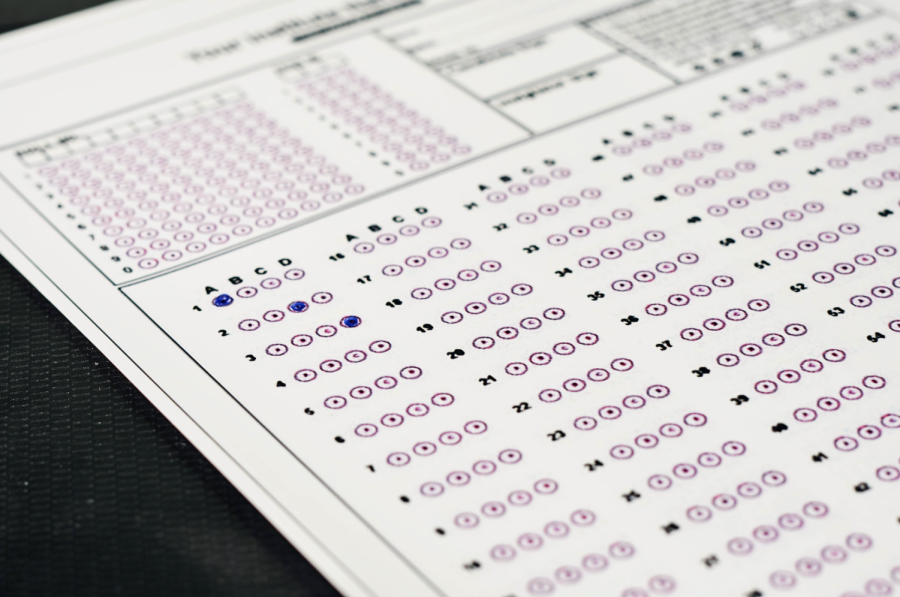Standardized Tests Add Unnecessary Stress for Students
May 17, 2022
With a myriad of exams that have encroached on Castaic High’s third school year, many students have begun to feel performance anxiety set in—and question if their effort is wasted.
As a teenager in my junior year, I’ve only just begun to feel the pressure of the testing season. The California Assessment of Student Performance and Progress (CAASPP) monopolizes the crucial month of April, which Advance Placement (AP) teachers take advantage of to prepare their students for the grueling exams awaiting them in May. Even after June 2, my glorious last day of school, I’m not in the clear. Students all over the country will be taking the Scholastic Aptitude Test (SAT)—and this will be my second time.
Many of these assessments are used for college admissions, where university employees will glance at applicants’ scores, grade point average (GPA), and extracurriculars. However, research suggests the CAASPP, SAT, and AP exams and courses are counterproductive for the students who are completing them.
The CAASPP is a mere memory at this point– two weeks wasted staring at laptop screens and scrolling mindlessly through an interface badly needing a redesign. California’s special cocktail of questions investigates high school students’ knowledge of language arts, science, and math.
Despite California’s constant enforcement of the test, students feel their work is going to waste. Results arrive by August, approximately two months after the previous school year concludes. Administrations claim these results indicate how effective teachers’ lessons are, but how does it help the students and their instructors? Teachers can’t view the results and cover lessons again—their students are in a whole new grade level by then, taking different classes.
Furthermore, especially for the science and math portions of state assessments, students taking different courses are all tested on the same standards. For example, in 9th grade I took biology, 10th AP Biology, 11th chose not to take science, and in 12th I will take physics. Since the CAASPP includes chemistry, students like me will not understand some of the questions being asked of them. Is it fair to evaluate students on standards they’ve never seen before because specific classes are not required?
Additionally, reports of scores are released to the public for every year of testing, and viewers can even filter them by site and school year. For instance, in the 2018 to 2019 school year, William S. Hart High School averaged 80.08% of students meeting English language arts standards, and only 43.53% met math standards.
Moving along, AP exams are another beast high school students tackle each year. The courses attract students with the allure of earning college credit and a GPA boost for a high school class. However, there are many flaws to this way of thinking, namely the fact that anyone can take these.
“I would say that two thirds of the students taking my class each year did not belong there. And they dragged down the course for the students who did,” stated John Tierney from The Atlantic. This would cause the fail rate of AP exams to increase over time due to underqualified students enrolling in a class not suited for their level.
Although students who achieve a score of three or higher on AP exams have been shown to perform better in college, some passing scores may not even count for college credit. Prestigious universities will instead reject AP scores as college credit, or only count the highest of scores. For example, Princeton requires a minimum score of a five, the highest possible result, in order to receive college credit for AP Biology. AP students, who often take a plethora of advanced courses, are driven by the promise of college credit. If a student received a four on their AP Biology exam, and couldn’t receive their promised credit, their hours of study time and $100 exam fee were exhausted.
Lastly, the SAT is finally being recognized as ineffective. Universities across the country are changing college applications to be SAT-optional, although MIT recently reversed this policy. Forbes pointed out that students’ scores who retake the SAT increase by 100 points on average, therefore the SAT measures retained knowledge through time and practice. The SAT measures how well students can study over a small period of time, and some on how well they cram the information. According to Forbes, GPA more accurately assesses students’ academic behavior over a much longer period—their whole high school career.
Moreover, according to the Washington Post, the SAT favors affluent families such as caucasian and Asian students. These wealthy households are able to afford tutors for months, and sometimes years, in advance to prepare their children. Additionally, according to College Board, only 5% of all SAT test-takers are Black. Because affluent students are more likely to take the exam and score the highest, this presents an unfair advantage to students of color and those who are impoverished.
Even though I have the choice of opting out of the SAT and AP exams, I am unfortunately at the College Board’s mercy. The possibility of scoring high enough on these assessments—to increase the likelihood of receiving acceptance into prestigious universities—is motivation alone. Conserving money on college courses that could end up costing thousands of dollars is also a shiny incentive. By the end of high school, I will have spent over $800 in exam fees. Undoubtedly, students similar to myself around the country feel the need to suffer through these courses and exams.
Although the CAASPP and SAT have proven to not be indicative of students’ academic abilities, and AP exams and courses prove to be a scourge, these exams are not likely to disappear anytime soon.




